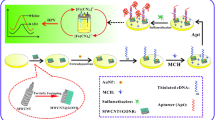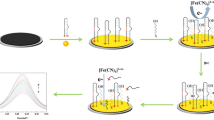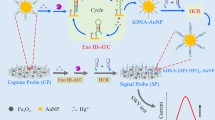Abstract
In this study, a nanocomposite consisting of three-dimensional reduced graphene oxide (3D-rGO) and plasma-polymerized propargylamine (3D-rGO@PpPG) was prepared and used as a highly sensitive and selective DNA sensor for detecting Hg2+. Given the high density of amino groups in the resultant 3D-rGO@PpPG nanocomposite, thymine-rich and Hg2+-targeted DNA was preferentially immobilized on the fabricated sensor surface via the strong electrostatic interaction between DNA strands and the amino-functionalized nanocomposites, followed by detecting Hg2+ through T–Hg2+–T coordination chemistry between DNA and Hg2+. The results of electrochemical measurements revealed that the anchored amount of DNA strands anchored on the 3D-rGO@PpPG nanofilm surface affects the determination of Hg2+ in aqueous solution. It showed high sensitivity and selectivity toward Hg2+ within concentrations ranging from 0.1 to 200 nM and displayed a low detection limit of 0.02 nM. The new strategy proposed also provides high selectivity of Hg2+ against other interfering metal ions, good stability, and repeatability. The excellent applicability of the developed sensor confirms the potential use of plasma-modified nanofilms for the detection of heavy metal ions in real environmental samples and water.






Similar content being viewed by others
References
Yoon S, Miller EW, He Q, Do PH, Chang CJ (2007) A bright and specific fluorescent sensor for mercury in water, cells, and tissue. Angew Chem Int Ed 46:6658–6661
Clarkson TW, Laszlo M, Myers GJ (2003) The toxicology of mercury—current exposures and clinical manifestations. New Engl J Med 349:1731–1737
Harris HH, Pickering IJ, George GN (2003) The chemical form of mercury in fish. Science 301:1203
Morel FM, Kraepiel AM, Amyot M (1998) The chemical cycle and bioaccumulation of mercury. Annu Rev Ecol Evol Syst 29:543–566
Caballero A, Martínez R, Lloveras V, Ratera I, Vidal-Gancedo J, Wurst K, Tárraga A, Molina P, Veciana J (2005) Highly selective chromogenic and redox or fluorescent sensors of Hg2+ in aqueous environment based on 1, 4-disubstituted azines. J Am Chem Soc 127:15666–15667
Chen P, He C (2004) A general strategy to convert the MerR family proteins into highly sensitive and selective fluorescent biosensors for metal ions. J Am Chem Soc 126:728–729
Coronado E, Galan-Mascaros JR, Marti-Gastaldo C, Palomares E, Durrant JR, Vilar R, Gratzel M, Nazeeruddin MK (2005) Reversible colorimetric probes for mercury sensing. J Am Chem Soc 127:12351–12356
Guo X, Qian X, Jia L (2004) A highly selective and sensitive fluorescent chemosensor for Hg2+ in neutral buffer aqueous solution. J Am Chem Soc 126:2272–2273
Nolan MA, Kounaves SP (1999) Microfabricated array of iridium microdisks as a substrate for direct determination of Cu2+ or Hg2+ using square-wave anodic stripping voltammetry. Anal Chem 71:3567–3573
Xu L, Yin H, Ma W, Kuang H, Wang L, Xu C (2015) Ultrasensitive SERS detection of mercury based on the assembled gold nanochains. Biosens Bioelectron 67:472–476
Angupillai S, Hwang JY, Lee JY, Rao BA, Son YA (2015) Efficient rhodamine-thiosemicarbazide-based colorimetric/fluorescent ‘turn-on’ chemodosimeters for the detection of Hg2+ in aqueous samples. Sensor Actuat B Chem 214:101–110
Hong YS, Rifkin E, Bouwer EJ (2011) Combination of diffusive gradient in a thin film probe and IC-ICP-MS for the simultaneous determination of CH3Hg+ and Hg2+ in Oxic Water. Environ Sci Technol 45:6429–6436
Liu S, Kang M, Yan F, Peng D, Yang Y, He L, Wang M, Fang S, Zhang Z (2015) Electrochemical DNA biosensor based on microspheres of cuprous oxide and nano-chitosan for Hg(II) detection. Electrochim Acta 160:64–73
Tanaka Y, Oda S, Yamaguchi H, Kondo Y, Kojima C, Ono A (2007) 15N-15NJ-coupling across Hg II: direct observation of Hg II-mediated TT base pairs in a DNA duplex. J Am Chem Soc 129:244–245
Miyake Y, Togashi H, Tashiro M, Yamaguchi H, Oda S, Kudo M, Tanaka Y, Kondo Y, Sawa R, Fujimoto T (2006) MercuryII-mediated formation of thymine-Hg II-thymine base pairs in DNA duplexes. J Am Chem Soc 128:2172–2173
Chang CC, Lin S, Wei SC, Chu SY, Lin CW (2012) Surface plasmon resonance detection of silver ions and cysteine using DNA intercalator-based amplification. Anal Bioanal Chem 402:2827–2835
Huy GD, Zhang M, Zuo P, Ye BC (2011) Multiplexed analysis of silver(I) and mercury(II) ions using oligonucletide-metal nanoparticle conjugates. Analyst 136:3289–3294
Li T, Dong S, Wang E (2010) A lead (II)-driven DNA molecular device for turn-on fluorescence detection of lead (II) ion with high selectivity and sensitivity. J Am Chem Soc 132:13156–13157
Yang X, Xu J, Tang X, Liu H, Tian D (2010) A novel electrochemical DNAzyme sensor for the amplified detection of Pb2+ ions. Chem Communications 46:3107–3109
Chen J, Zhou X, Zeng L (2013) Enzyme-free strip biosensor for amplified detection of Pb2+ based on a catalytic DNA circuit. Chem Commun 49:984–986
Long Y, Jiang D, Zhu X, Wang J, Zhou F (2009) Trace Hg2+ analysis via quenching of the fluorescence of a CdS-encapsulated DNA nanocomposite. Anal Chem 81:2652–2657
Ding X, Kong L, Wang J, Fang F, Li D, Liu J (2013) Highly sensitive SERS detection of Hg2+ ions in aqueous media using gold nanoparticles/graphene heterojunctions. ACS Appl Mater Interfaces 5:7072–7078
Liu X, Tang Y, Wang L, Zhang J, Song S, Fan C, Wang S (2007) Optical detection of mercury (II) in aqueous solutions by using conjugated polymers and label-free oligonucleotides. Adv Mater 19:1471–1474
Peng H, Zhang L, Soeller C, Travas-Sejdic J (2009) Conducting polymers for electrochemical DNA sensing. Biomater 30:2132–2148
Goddard JM, Hotchkiss J (2007) Polymer surface modification for the attachment of bioactive compounds. Prog Poly Sci 32:698–725
Qiu S, Gao S, Liu Lin Z, Qiu B, Chen G (2011) Electrochemical impedance spectroscopy sensor for ascorbic acid based on copper (I) catalyzed click chemistry. Biosensor Bioelectron 26:4326–4330
Liu C, Li F, Ma LP, Cheng HM (2010) Advanced materials for energy storage. Adv Mater 22:E28–E62
Pumera M (2011) Graphene-based nanomaterials for energy storage. Energy Environ Sci 4:668–674
Wang Y, Li Z, Wang J, Li J, Lin Y (2011) Graphene and graphene oxide: biofunctionalization and applications in biotechnology. Trends Biotech 29:205–212
Shao Y, Wang J, Wu H, Liu J, Aksay IA, Lin Y (2010) Graphene based electrochemical sensors and biosensors: a review. Electroanal 22:1027–1103
Cao X, Shi Y, Shi W, Lu G, Huang X, Yan Q, Zhang Q, Zhang H (2011) Preparation of novel 3D graphene networks for supercapacitor applications. Small 7:3163–3168
Xu Y, Wu Q, Sun Y, Bai H, Shi G (2010) Three-dimensional self-assembly of graphene oxide and DNA into multifunctional hydrogels. ACS Nano 4:7358–7362
He L, Zhang Y, Liu S, Fang S, Zhang Z (2014) A nanocomposite consisting of plasma-polymerized propargylamine and graphene for use in DNA sensing. Microchim Acta 181:1981–1989
Yang Y, Kang M, Fang S, Wang M, He L, Zhao J, Zhang H, Zhang Z (2015) Electrochemical biosensor based on three-dimensional reduced graphene oxide and polyaniline nanocomposite for selective detection of mercury ions. Sensor Actuator B-Chem 214:63–69
Marx KA (2003) Quartz crystal microbalance: a useful tool for studying thin polymer films and complex biomolecular systems at the solution-surface interface. Biomacromolecules 4:1099–1120
Pajkossy T (1994) Impedance of rough capacitive electrodes. J Electroanal Chem 364:111–125
Wang M, Wang L, Yuan H, Ji X, Sun C, Ma L, Bai Y, Li T, Li J (2004) Immunosensors based on layer-by-layer self-assembled au colloidal electrode for the electrochemical detection of antigen. Electroanalysis 16:757–764
Levie DR (1965) The influence of surface roughness of solid electrodes on electrochemical measurements. Electrochim Acta 10:113–130
Yuan Y, Gao M, Liu G, Chai Y, Wei S, Yuan R (2014) Sensitive pseudobienzyme electrocatalytic DNA biosensor for mercury(II) ion by using the autonomously assembled hemin/G-quadruplex DNAzyme nanowires for signal amplification. Anal Chim Acta 811:23–28
Liu S, Nie H, Jiang J, Shen G, Yu R (2009) Electrochemical sensor for mercury (II) based on conformational switch mediated by interstrand cooperative coordination. Anal Chem 81:5724–5730
Noorbakhsh A, Salimi A (2011) Development of DNA electrochemical biosensor based on immobilization of ssDNA on the surface of nickel oxide nanoparticles modified glassy carbon electrode. Biosensor Bioelectron 30:188–196
Seah M (1980) The quantitative analysis of surfaces by XPS: a review. Surf Interface Anal 2:222–239
Dementjev A, De Graaf A, Van de Sanden M, Maslakov K, Naumkin A, Serov A (2000) X-ray photoelectron spectroscopy reference data for identification of the C3N4 phase in carbon–nitrogen films. Diam Relat Mater 9:1904–1907
Wang P, Kang M, Sun S, Liu Q, Zhang Z, Fang S (2014) Imine-linked covalent organic framework on surface for biosensor. Chin J Inorg Chem 32:838–843
Cai S, Lao K, Lau C, Lu J (2011) “Turn-on” chemiluminescence sensor for the highly selective and ultrasensitive detection of Hg2+ ions based on interstrand cooperative coordination and catalytic formation of gold nanoparticles. Anal Chem 83:9702–9708
Lou X, Zhao T, Liu R, Ma J, Xiao Y (2013) Self-assembled DNA monolayer buffered dynamic ranges of mercuric electrochemical sensor. Anal Chem 85:7574–7580
Dong ZM, Zhao GC (2012) Quartz crystal microbalance aptasensor for sensitive detection of mercury(II) based on signal amplification with gold nanoparticles. Sensors 12:7080–7094
Lu X, Dong X, Zhang K, Zhang Y (2012) An ultrasensitive electrochemical mercury (II) ion biosensor based on a glassy carbon electrode modified with multi-walled carbon nanotubes and gold nanoparticles. Anal Methods 4:3326–3331
Wang M, Liu S, Zhang Y, Yang Y, Shi Y, He L, Fang S, Zhang Z (2014) Graphene nanostructures with plasma polymerized allylamine biosensor for selective detection of mercury ions. Sensor Actuator B-Chem 203:497–503
Xu JL, Khor KA (2007) Chemical analysis of silica doped hydroxyapatite biomaterials consolidated by a spark plasma sintering method. J Inorg Biochem 101:187–195
Guo YF, Yan NQ, Yang SJ, Liu P, Wa J, Qu Z, Jia JP (2012) Conversion of elemental mercury with a novel membrane catalytic system at low temperature. J Hazard Mater 213–214:62–70
Stoica A, Manakhov A, Polčák J, Ondračka P, BuršíkováV Zajíčková R, Zajíčková L, Stoica A, Manakhov A (2015) Cell proliferation on modified DLC thin films prepared by plasma enhanced chemical vapor deposition Cell proliferation on modified DLC thin films prepared by plasma enhanced chemical vapor deposition. Biointerphases 10:029520–029529
Manakhov A, Nečas D, Čechal J, Pavliňák D, Eliáš M, Zajíčková L (2015) Deposition of stable amine coating onto polycaprolactone nanofibers by low pressure cyclopropylamine plasma polymerization. Thin Solid Films 581:7–13
Manakhov A, Skládal P, Nečas D, Čechal J, Polčák J, Eliáš M, Zajíčková L (2014) Cyclopropylamine plasma polymers deposited onto quartz crystal microbalance for biosensing application. Phys Status Solidi 211:2801–2808
Kingshot P, Thissen H, Griesser H (2002) Effects of cloud-point grafting, chain length, and densityof PEG layers on competitive adsorption of ocular proteins. Biomaterials 23:2043–2056
Majumder S, Priyadarshini M, Subudhi U, Chainy GBN, Shikha V (2009) X-ray photoelectron spectroscopic investigations of modifacations in plasmid DNA after interaction with Hg nanoparticles. Appl Surf Sci 256:438–442
Acknowledgments
This work was supported by Program for the National Natural Science Foundation of China (NSFC: Account No. 51173172), Science and Technology Opening Cooperation Project of Henan Province (Account No. 132106000076), and Innovative Technology Team of Henan Province.
Author information
Authors and Affiliations
Corresponding authors
Electronic supplementary material
Below is the link to the electronic supplementary material.
Rights and permissions
About this article
Cite this article
Peng, D.L., Ji, H.F., Dong, X.D. et al. Highly Sensitive Electrochemical Bioassay for Hg(II) Detection Based on Plasma-Polymerized Propargylamine and Three-Dimensional Reduced Graphene Oxide Nanocomposite. Plasma Chem Plasma Process 36, 1051–1065 (2016). https://doi.org/10.1007/s11090-016-9707-4
Received:
Accepted:
Published:
Issue Date:
DOI: https://doi.org/10.1007/s11090-016-9707-4




